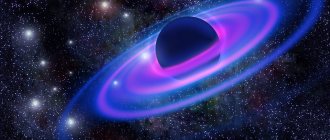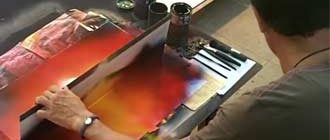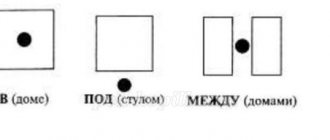About the stars and the dream of flying to them
Since ancient times, people have loved looking at the night sky. They were always interested in the question: “Who lights the lights high up there that they see here on Earth?” They came up with various legends and fairy tales in which they dreamed of rising high, high and reaching these heavenly lights. In the Old Russian language, the word “star” meant “to shine,” “to shine.” Indeed, stars are the brightest celestial bodies in all of space, and our Sun is just one of the billions of bright luminaries that are found only in our galaxy. And it is so big because, unlike other stars, it is very close to us. The further away a star is, the less visible it is to us. And some are so far away that they can only be seen through a special device - a telescope. The science of astronomy studies stars, planets, galaxies and the Universe.
The sun, like other stars, is a huge ball of fire. The temperature inside each of these balls is different, so the color and brightness of the stars are also different. White balls-stars have the highest temperature (from 10,000 to 30,000 C), blue ones - a little lower, then come yellow (6,000 C) and the last ones are red (2,000-3,000 C). Among them there are both huge giant stars and small dwarfs. Our Sun is a yellow dwarf star (despite its impressive size according to our understanding) and the temperature on its surface is 5780 kelvin (this is a unit of thermodynamic temperature).
What is a galaxy? This is a whole cluster of stars and star systems. Among them there are some similar to our solar system, and there are others in which not one, like ours, but two or three (sometimes more) stars and each has its own planets.
People learned about all this not so long ago, only about a thousand to one and a half thousand years ago. And even then they dreamed of flying to these distant “suns” and seeing if there was life there. But it's not that easy! After all, the distance to the closest stars to us - Sirius and Aldebaran - is so enormous that it takes hundreds of years to fly to them on modern space rockets.
Previously, when there were no telescopes and people saw only those stars that they could see with their eyes, they connected the brightest of them with invisible lines and called such groups of stars constellations. They drew them on their star maps and atlases in the form of animals, birds, people or some objects. In ancient times, sailors used these constellations to find their way home when returning from long journeys.
All constellations are divided into constellations of the Northern Hemisphere, that is, those that are visible from the northern half of the Earth, and constellations of the Southern Hemisphere, visible only to residents living on the southern half of our planet. The southern constellations include:
- Scales;
- Capricorn;
- Hare;
- Microscope;
- Southern Cross and others.
And to the northern ones:
- Big Dipper;
- Ursa Minor;
- Cassiopeia;
- Giraffe;
- Taurus and many others.
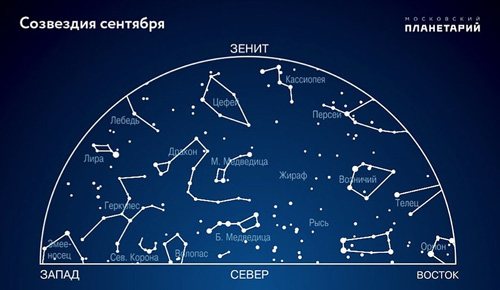
The ancient Greeks, observing the movement of stars all year round, noticed that during this period of time the Earth passes through the “belt” of constellations, and there are exactly 12 of them, just like there are months in a year. Such clusters of stars were called the signs of the zodiac. And all of them, like many others, like our Sun, are part of a galaxy system called the Milky Way.
Fairy tale Flight of a cockerel into space
The author of the tale is Syrovatina Olga Nikolaevna. Publication date 04/07/2020
One day we met Goose, Rooster and Dog on the path. The goose immediately decided to show them that he was not of a simple race, stretched out his neck and hissed loudly at them.
- Why are you meeting travelers like this? - the Dog and the Rooster asked him.
“This is because I am the granddaughter of Grandmother Goose, who, in search of warm countries, flew around the whole Earth, proudly,” said the Goose.
“Then I should just bite you, since my great-grandmother flew into space,” said the Dog.
- What kind of space is this? - asked the Rooster.
“He is over there, above the clouds, from where the sun, moon and stars shine for us,” said the Dog.
- After all, dogs don’t have wings. How did she get there? - asked Goose.
“My great-grandmother’s name was Squirrel,” said the Dog.
- Here she is with her friend Strelka - she has been preparing for this flight into space for a long time. They trained, got used to heights and weightlessness - my mother told me about this, and her grandmother told her about it.
“So I come from a famous family,” said the Dog. But the Rooster stood sad, hung his head, lowered his crest to one side.
- But I have nothing to brag about!
“But, nothing,” the Rooster perked up, flapped his wings and K-ka-re-ku! - he screamed at the top of his lungs.
“Then I myself will fly into this very space to become famous and glorify my family,” said the Rooster.
- How will you fly? After all, you don't have a rocket! - said the Dog.
“But I have a magic feather,” answered the Rooster.
“And it fulfills all desires,” he pulled out an inconspicuous gray feather from his tail.
“One, two, three,” said the Cockerel.
“I want a rocket to appear here, in this clearing!” And as soon as he said this, a silver rocket immediately appeared, and from the rays of the sun a whole shiny rocket appeared.
- How will you fly? After all, they train for a long time for this, it’s not easy, you need to prepare for a flight into space,” said the Dog.
“Why all this training when you have a magic feather,” answered the Rooster. He immediately got into the rocket. The engines started working, and she rushed into the sky. The rocket flew away, and the Dog and Goose remained in the clearing to await his return. And as it turned out, we didn’t have to wait long at all!
So our hero, the Rooster, has returned. He did not come out, but simply fell out of the rocket. The Dog and Goose rushed to his aid, and the Rooster barely raised his head and whispered:
“I don’t need your space anymore!” I don't need your fame! I barely survived; at first I was pressed into the chair on which I was sitting. Then it curled me into a ball, and then stretched me like a spring. I looked out the window, and there was complete blackness, and I couldn’t see anything! I had to abort the flight and return to Earth while I was still alive! It was a bad idea,” said the Rooster.
- Here you see! Your vanity almost ruined you, Cockerel! - said Goose.
- Don’t get in your sleigh! - said the Dog.
Source
A story about the planets of the solar system
We already know what stars are, but what are planets, what are they like and how many of them have gathered around our Sun?
Any planet is a celestial body that, unlike asteroids, comets and stars, does not rush through the space of the universe, but is “tied” to one place - to its star, around which it rotates in a specially designated orbit. And, unlike stars and comets, these objects are not so hot and some of them have their own atmosphere.
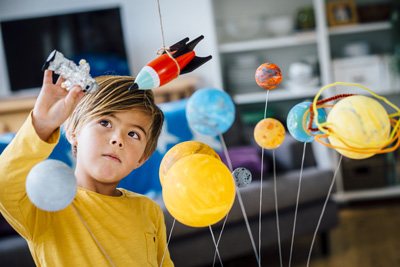
Almost all the planets currently studied by astronomers (scientists who study the Universe) are not suitable for human life, except for Earth. But this does not mean that we are alone in the entire vast Universe. It is quite possible that someday, on some distant planet, there will be another intelligent life.
In the meantime, scientists are carefully studying the planets closest to the Sun - the planets of our system. And we have as many as eight of them, along with the Earth. Astronomers suggest that there is also a ninth planet, but so far there is no real evidence of it, only a hypothesis.
- Mercury is closest to our Sun and is the smallest planet. On its surface there are many craters and ledges from meteorites and from the so-called “solar wind”, which were formed due to the atmosphere being too rarefied. Mercury has no satellites.
- Venus is very similar in size to the Earth, but its atmosphere is 90 times denser than the Earth’s and, naturally, it is impossible to breathe in it. In addition, it is the hottest planet in our system. Venus also has no satellites.
- The earth is our home and the atmosphere on it, and its nature are unique. Scientists have not yet found such a second planet. Our night satellite is called the Moon.
- Mars is the fourth planet from the sun. It is slightly smaller in size than Venus and Earth. Volcanoes, depressions, and seas (though without water) were discovered on its surface. Mars has two satellites. They are called Deimos and Phobos, which means “Horror” and “Fear” in Greek.
- Jupiter is a giant planet and has as many as 79 satellites. The four largest are:
- And about;
- Callisto;
- Europe;
- Ganymede.
- Saturn is famous for its rings, which are formed from cosmic dust and ice, and fit so tightly together and rush around the planet at such great speed that they are seen from Earth as giant rings. Saturn has even more satellites than Jupiter - as many as 82. The most famous are Enceladus and Titan.
- Uranus is 14 times larger than Earth! And it has as many as 27 satellites, the largest of which are:
- Miranda;
- Umbriel;
- Ariel;
- Titania;
- Oberon.
- Neptune, although smaller in size than Uranus, is denser and heavier. It has 14 satellites and one of them - Triton - even moves in a different direction from the others.
Space is a huge and unknown world that people have only just begun to explore. And the first cosmonaut who left the Earth on a spaceship was our compatriot Yuri Gagarin. And it was on April 12 that people’s dream of seeing the Earth from space came true.
Profession astronaut
Do you dream of becoming an astronaut?
If yes, then this story is for you! The word " astronaut " comes from the Greek words meaning "space" and "seafarer". That is, it turns out that the astronaut floats in space, making flights to conduct scientific observations and experiments. In order to become an astronaut, you need to be a courageous and confident person, because unexpected situations often arise during a flight. Cosmonaut number one was Yuri Gagarin .
In order to become an astronaut, you need to undergo many tests and special training . The Cosmonaut Training Center is located in Star City near Moscow. If you are in good health and academic performance, you can apply to join the cosmonaut corps, even as a student. But it is worth knowing that people with higher education, physicists, biologists or military personnel are allowed to be tested. Artists and accountants are not taken into space, since scientific experiments and experiments need to be carried out at the station.
An astronaut must know space technology, be able to pilot his spacecraft and carry out repair work on the orbital space station. The chance to become an astronaut is available to people between 27 and 30 years old, up to 175 cm tall and weighing up to 75 kg. You need to have excellent health: perfect vision, absence of chronic diseases and bad habits. And it is imperative to be fluent in English , since this is the language used to communicate on the International Space Station.
At the first stage, about 350 people are selected from questionnaires. Tests are arranged for them in physics, mathematics and the Russian language. Then applicants undergo a strict medical examination, after which approximately 50 people remain. The most recent test takes place at the very center of cosmonaut training, here they look to see whether a person can withstand difficult tests. For example, a future cosmonaut is locked for 5 days in a closed space, where he cannot communicate with anyone and where complete silence reigns and they watch how he behaves. As a result, only 8 of the most persistent lucky ones remain , who are enrolled in the cosmonaut corps for pre-flight training. But even here, not everything is so simple. They prepare to go into space from 5 to 10 years. Classes are held in classrooms, gyms, and on a rapidly rotating machine). Future cosmonauts pay a lot of attention to flying on airplanes, parachute jumping, working in a “zero-gravity hydropool”, learning to endure overloads and weightlessness, heat and cold.
Now there are three main specialties for astronauts
— Test cosmonaut . This is a spaceship pilot. His task is to pilot the aircraft, take off, land, coordinate the work of all systems and crew actions. Test cosmonauts are recruited from among military pilots.
— Cosmonaut-engineer. He maintains the ship's technical systems, coordinates pre- and post-flight preparation of the aircraft, and participates in the development and testing of new technical systems. During the flight, performs all necessary repair work.
— Cosmonaut-researcher .. He is responsible for the health of crew members, conducts experiments, studies the behavior of living organisms in conditions of weightlessness. Research cosmonauts are required to be included in long-term expeditions.
Source
